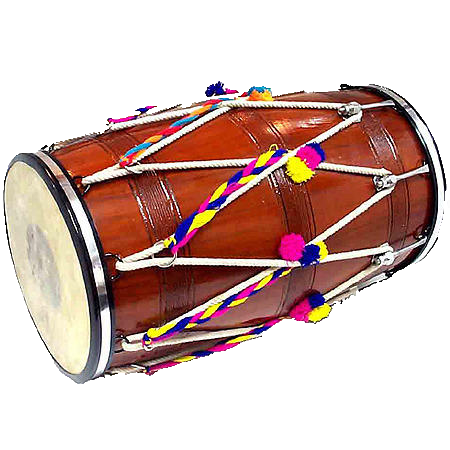There is nothing uncommon about this musical instrument. It Is a very common, however a very famous musical instrument, used extensively in all forms of Indian music. The player is called as “Dholiâ€.
It is a very famous folk drum of North India, Pakistan and Bangladesh. It is like a typical barrel shaped drum with skins on both the openings, wherein one side has a high pitch and the other has a lower pitch. It is a larger version of Dholak. Any large barrel or cylindrical drum is termed as a dhol.
The word Dhol is derived from a Persian “Doholâ€, however it has a Indo-European connection as it has been found the in the ancient images of Mughal Era.
Dhol‘s are usually made of Mango wood and Shisham. Mango wood is used for making the drum shell and the membranes are made of goat skin. One side of the opening is covered with thicker goat skin and the other with a little thinner. The combination of this thicker skin and the paste applied on it before performance known as Dhol Masala gives a deeper sound.
There are various ways of tightening a Dhol, at times they are laced with rope or rawhide wherein a series of metal rings are used to pull and tighten the instrument and many a times turnbuckles are used.

There are various types od dhol‘s and used in a different way in every region of india.
Punjab: – It plays a very important role in Punjabi culture. Punjabi dhol is also known as a Bhangra Dhol due to its importance in folk music and song style. Punjabi dhol is played with sticks in both the hands
Gujarat: – The Dhol has a very important presence in the state of Gujarat. The dance forms like Raas and Garba are linked to Gujarati sense of self identity and dhol is a very important instrument used extensively in Raas and Garba.
South India: – Dhol has a very little presence in South India. The most commonly used instrument in South India is “Tavilâ€. It is nothing but south Indian version of Dhol. The material used and the technique to play is all the same as the Dhol.
Tribal India: – In tribal India the dhol is very popularly represented. There are so many variations in technique and construction that entire books could be written on the subject. Unfortunately there is no single culture or single entity that can be defined as tribal India, for it is a collection of largely unrelated smaller cultures.
There are various types od dhol‘s and used in a different way in every region of india.
Punjab
It plays a very important role in Punjabi culture. Punjabi dhol is also known as a Bhangra Dhol due to its importance in folk music and song style. Punjabi dhol is played with sticks in both the hands
Gujarat
The Dhol has a very important presence in the state of Gujarat. The dance forms like Raas and Garba are linked to Gujarati sense of self identity and dhol is a very important instrument used extensively in Raas and Garba.
South India
Dhol has a very little presence in South India. The most commonly used instrument in South India is “Tavilâ€. It is nothing but south Indian version of Dhol. The material used and the technique to play is all the same as the Dhol.
Tribal India
In tribal India the dhol is very popularly represented. There are so many variations in technique and construction that entire books could be written on the subject. Unfortunately there is no single culture or single entity that can be defined as tribal India, for it is a collection of largely unrelated smaller cultures.